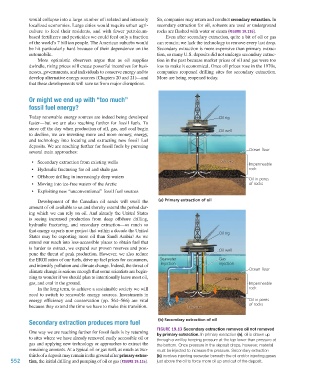Page 553 - Environment: The Science Behind the Stories
P. 553
would collapse into a large number of isolated and intensely So, companies may return and conduct secondary extraction. In
localized economies. Large cities would require urban agri- secondary extraction for oil, solvents are used or underground
culture to feed their residents, and with fewer petroleum- rocks are flushed with water or steam (FIGURE 19.13b).
based fertilizers and pesticides we could feed only a fraction Even after secondary extraction, quite a bit of oil or gas
of the world’s 7 billion people. The American suburbs would can remain; we lack the technology to remove every last drop.
be hit particularly hard because of their dependence on the Secondary extraction is more expensive than primary extrac-
automobile. tion, so many U.S. deposits did not undergo secondary extrac-
More optimistic observers argue that as oil supplies tion in the past because market prices of oil and gas were too
dwindle, rising prices will create powerful incentives for busi- low to make it economical. Once oil prices rose in the 1970s,
nesses, governments, and individuals to conserve energy and to companies reopened drilling sites for secondary extraction.
develop alternative energy sources (Chapters 20 and 21)—and More are being reopened today.
that these developments will save us from major disruptions.
Or might we end up with “too much”
fossil fuel energy?
Today renewable energy sources are indeed being developed Oil rig
faster—but we are also reaching farther for fossil fuels. To
stave off the day when production of oil, gas, and coal begin Oil well
to decline, we are investing more and more money, energy,
and technology into locating and extracting new fossil fuel
deposits. We are reaching further for fossil fuels by pursuing
several main approaches: Ocean floor
• Secondary extraction from existing wells Gas cap Impermeable
• Hydraulic fracturing for oil and shale gas rock
• Offshore drilling in increasingly deep waters Oil in pores
• Moving into ice-free waters of the Arctic of rocks
• Exploiting new “unconventional” fossil fuel sources
Development of the Canadian oil sands will swell the (a) Primary extraction of oil
amount of oil available to us and thereby extend the period dur-
ing which we can rely on oil. And already the United States
is seeing increased production from deep offshore drilling,
hydraulic fracturing, and secondary extraction—so much so
that energy experts now project that within a decade the United Oil rig
States may be exporting more oil than Saudi Arabia! As we
extend our reach into less-accessible places to obtain fuel that
is harder to extract, we expand our proven reserves and post- Oil well
pone the threat of peak production. However, we also reduce
the EROI ratios of our fuels, drive up fuel prices for consumers, Seawater Gas
and intensify pollution and climate change. Indeed, the threat of injection injection
climate change is serious enough that some scientists are begin- Ocean floor
ning to wonder if we should plan to intentionally leave most oil, Gas cap
gas, and coal in the ground. Impermeable
In the long term, to achieve a sustainable society we will rock
need to switch to renewable energy sources. Investments in
energy efficiency and conservation (pp. 564–566) are vital Oil in pores
because they extend the time we have to make this transition. Pressure of rocks
Pressure
Secondary extraction produces more fuel (b) Secondary extraction of oil
FIGURE 19.13 Secondary extraction removes oil not removed
One way we are reaching further for fossil fuels is by returning by primary extraction. In primary extraction (a), oil is drawn up
to sites where we have already removed easily accessible oil or through a well by keeping pressure at the top lower than pressure at
gas and applying new technology or approaches to extract the the bottom. Once pressure in the deposit drops, however, material
remaining amounts. At a typical oil or gas well, as much as two- must be injected to increase the pressure. Secondary extraction
thirds of a deposit may remain in the ground after primary extrac- (b) involves injecting seawater beneath the oil and/or injecting gases
552 tion, the initial drilling and pumping of oil or gas (FIGURE 19.13a). just above the oil to force more oil up and out of the deposit.
M19_WITH7428_05_SE_C19.indd 552 12/12/14 5:23 PM

